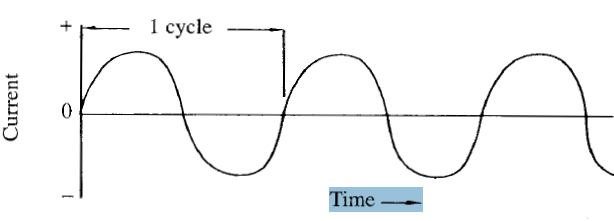WHAT IS ELECTRIC CURRENT
In the very early days of magnetic particle testing, it was believed that the most desirable current for magnetization was direct current provided by storage batteries. As knowledge of the magnetic particle process expanded and electrical circuitry continued to advance, many types of magnetizing currents became available: alternating current, half wave direct current and full wave direct current. The terms half wave rectified direct current and full wave rectified direct current are used for alternating current rectified to produce half
wave and full wave direct current. Three types of electric current are
used in magnetic particle testing.
1 . Alternating current.
2. Full wave direct current.
3. Half wave direct current.
Alternating current is used for the detection of surface discontinuities only, whereas full wave direct or half wave direct currents are used for either surface or subsurface discontinuities.
Alternating Current
Alternating current is useful in many applications because it is commercially available. Electrical circuitry to produce alternating magnetizing current is simple and relatively inexpensive because it only requires transforming commercial power into low voltage, high amperage magnetizing current.
In the United States and some other countries, alternating current alternates sixty times per second. Many other countries have standardized fifty alternations per second. The alternations are called cycles. One hertz equals one cycle per second, and 60 Hz is sixty cycles per second. Figure shows the waveform of alternating current. In one cycle, the current flows from zero to a maximum positive value and then drops back to zero. At zero, it reverses
direction and goes to a maximum negative peak and returns to zero.
The curve is symmetrical, with the positive and negative lobes being mirror images. The use of alternating current in magnetic particle testing is
recommended for the detection of surface discontinuities that comprise the majority of service induced discontinuities. Fatigue and Stress corrosion cracks are examples of cracks usually open to the surface.
Alternating current waveform
The shallow penetration of alternating current fields into the test object at the usual power line frequencies of 50 and 60 Hz precludes the use of alternating current for the detection of subsurface discontinuities. The shallow penetration is caused by skin effect.
Skin effect is the crowding of magnetic flux or electric current outward and away from the test object center. The skin effect is the reason alternating current is recommended when testing for service induced surface discontinuities. However, the skin effect of alternating current is less at lower frequencies, resulting in deeper penetration of the lines of force. At twenty-five cycles, the penetration is demonstrably deeper, and at frequencies of ten cycles
per second and less, the skin effect is almost nonexistent.
Alternating current has another advantage in that the magnetizing effect, which is determined by the value of the peak current at the top of the sine wave of the cycle, is 1.41 times that of the current read on the meter.
